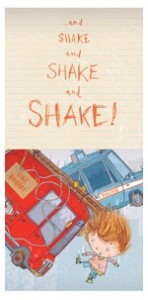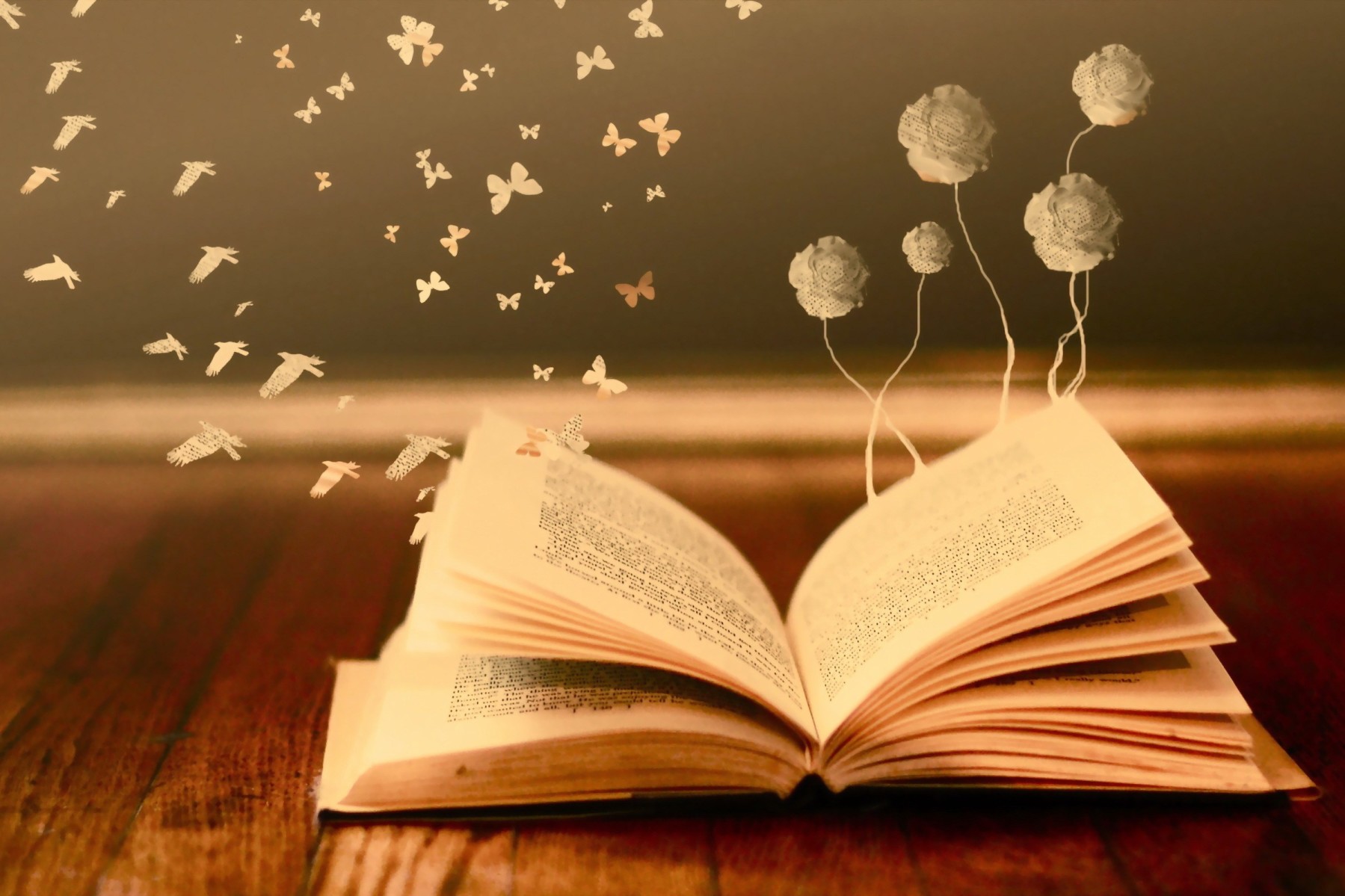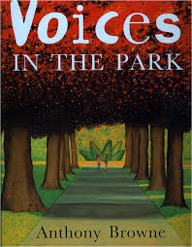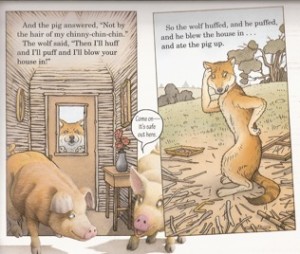As a literacy teacher educator and former third grade teacher, I get excited when I discover a really great book – like game show, come-on-down, hit-the-jackpot-excited. While I enjoy all kinds of children’s and young adult books, I most often find myself drawn to books others might describe as weird or odd. My quest for these unique books has led me to discover and fall in love with a genre that has come into its own in recent years – postmodern picture books.
The word postmodern means a number of things, depending on whether you ask an artist, minister, architect, fashion designer or singer. Generally speaking, postmodernism emerged in the mid-20th century and is characterized by a mocking of traditional art forms. Today, creators of picture books are pushing the boundaries of what readers expect to encounter when they pick up a picture book.
Postmodern picture books are awesome because:
1. They need you to participate.
Laziness will not be tolerated. Many postmodern picture books need you to actually do things to make them work. For example, in This Book Just Ate My Dog (Byrne, 2014), a girl loses her dog, her friends, fire and ambulance workers, and eventually herself within the spine of the book in the reader’s hands. The readers must shake the book to rescue everyone.

Press Here (Tullet & Franceschelli, 2011) invites readers to press, shake, and manipulate the colorful dots on the pages throughout the story.
 2. The characters talk to you.
2. The characters talk to you.
Postmodern picture books often acknowledge you, the reader. Remember the classic The Monster at the End of this Book (Stone & Smollin, 1971)? Grover is upset because there is a monster at the end of the book and he DOES NOT want you to turn the page. Seriously! In a more recent example, Do Not Open This Book! (Muntean & Lemaitre, 2006) features a pig working in a cluttered workshop, surrounded by tools and boxes of punctuation marks, letters, and words. He greets readers with his angry eyes and a no-nonsense warning against entering the book because it is not written yet.
Throughout the book, the reader continues to annoy the main character by turning the pages before the pig has written the story.
3. They make you question your sanity.
Readers of postmodern picture books find themselves wondering where to draw the line between reality and fiction. For example, Lehman’s (2004) The Red Book, a wordless picture book, features a girl who finds a red book in the snow as she is walking to school. She is intrigued by the friend she observes in the pages of the book and actually enters the book in order to journey to meet him. When I observed fourth grade kids talking about this book, Lizzie asked the group a compelling question, “Are we the readER or is somebody reading us?” So deep, right? Tyler responded, “Where’s the person that’s supposed to be watching us?” The students thoughtfully looked around the room and up at the ceiling. The opportunity for readers to co-construct understandings with authors is too good to pass up.
4. They make fun of and mix up your favorite stories.
Postmodern picture books often employ parodic devices, resulting in the mocking of traditional or familiar stories. Wait! No Paint! (Whatley, 2001) is an alternative version of the familiar story of the three pigs. In this tale, the pigs are at the mercy of an illustrator who accidentally spills his juice on the pages of their story and runs out of red paint as he is illustrating the story, leaving the pigs feeling embarrassed by their pale appearance. Intertextuality is another common postmodern picture book device in which familiar stories are intertwined.

In Who’s Afraid of the Big Bad Book (Child, 2003), Herb falls asleep on one of his favorite old books. He awakens to find that he has entered the fairytales of the book and has some interesting encounters with various fairy tale characters including Little Red Riding Hood, Rapunzel, Cinderella, and The Three Bears. Herb comes to realize that some of the book characters are irritated with him because of his past mistreatment of the book, for example, the time he drew a mustache on the Queen.
5. They make you use your noggin.
What parent or educator isn’t tired of the same old predictable, simple stories? Postmodern picture books diverge from traditional and linear plots. Black and White (Macaulay, 1990) tells a story in four seemingly unconnected quadrants on each two-page spread. At the conclusion of the story, the reader wonders if and how the stories are connected. The final page features a hand entering the page and lifting part of the setting – the train station – out of the book. The indeterminate plot leaves the reader to draw his or her own conclusions.

Voices in the Park (Browne, 1998) features divergence from the traditional plot grammar of beginning, middle, and end. This picture book tells the story of a visit to the park from the perspective of four different characters, resulting in four consecutive beginnings, middles, and endings. Must think! Must re-read!
6. They Look Cool.
Open postmodern picture books and you are likely to see strange things: objects sliding off of pages, characters jumping in and out of the surface of pages, and hidden surrealistic illustrative details. The Three Pigs (Wiesner, 2001) begins like the familiar story of the three pigs, but readers quickly realize that something is different when the first little pig gets blown out of the story frame.
As the pig exits the story frame, his appearance changes from a flat cartoon-like illustration to a three-dimensional, more realistic drawing. The pig suddenly appears to be standing on top of the page. Several times, characters appear half-cartoon and half-realistic as they step out of the book and into reality or into another story frame.
7. They prepare you for literacy in a digital age.
Clearly, readers’ expectations are challenged and they are required to engage with text in new and different ways. From an educational perspective, this genre has the potential to prepare kids to navigate the digital world that surrounds them. Literacy in the 21st century means thinking critically, making sense of a bombardment of media sources, and making choices about what to read and how to go about reading it. For example, the Internet provides a highly interactive experience in which users navigate multiple nonlinear pathways, and surfing the Internet requires users to make choices about which link they click on and which part of the screen they will read first. Our digital world is characterized by nonlinearity and interactivity, two of the characteristics that are consistently cropping up in the postmodern picture book genre.
—————
When I asked a fourth grade book club if they thought it was a good idea to read postmodern picture books, they all said yes. This came as a bit of a surprise to me, as some of the kids initially showed strong resistance to a few of the books during book club discussions. By employing alternative literary devices and illustrative characteristics, postmodern picture books push the boundaries of reader’s expectations, encouraging readers to question the line between reality and fiction and ponder multiple meanings. The postmodern picture book genre warrants the attention of educators and parents for its potential to encourage critical thinking, toleration of ambiguity, and generation of multiple meanings. Check them out, read them, and talk about them!
Swaggerty, E. A. (2009). “That just really knocks me out”: Fourth grade students navigate postmodern picture books. Journal of Language and Literacy Education, 5(1), 9-33. Available http://jolle.coe.uga.edu/archive/2009_1/2_Swaggerty.pdf
A Short Annotated Bibliography of Picture Books with Postmodern Characteristics
Becker, A., 1974. (2013). Journey. Somerville, Massachusetts: Candlewick Press.
A beautiful wordless picture book about a girl who draws a magic door on her bedroom wall and through it enters a new world full of adventure.
Browne, A. (1998). Voices in the park. New York: DK Publishing, Inc.
Intriguing illustrations with hidden details and a unique narrative style tell the story of a visit to the park from the perspective of four different characters.
Burleigh, R. & Yaccarino ,D. (2001). I love going through this book. Hong Kong: HarperCollins.
Readers follow a boy as he journeys through the pages of a book, narrating in rhyme and embracing the adventures he encounters on each page.
Byrne, R. (2014). This book just ate my dog! New York: Henry Holt and Company.
Bella’s dog disappears into the gutter of the book, and adventure ensues as she invites the reader to help.
Child, L. (2003). Who’s afraid of the big bad book? Hyperion.
Herb falls asleep on his favorite book of fairytales and awakens inside the book, discovering that he is responsible for the unhappiness of many of the characters because of his past mistreatment of the book.
Cleminson, K. (2012). Otto the book bear (1st U. S. ed.). New York: Disney/Hyperion Books.
Otto lives in a book and is happiest when his story is being read. He walks off of his book’s pages and the book is taken away, causing Otto to embark on a quest for a new home.
Felix, M. (1980). The story of a little mouse trapped in a book. La Jolla CA: Green Tiger Press.
An older title, this clever wordless picture book features a mouse who chews his way out of the picture book he is trapped in and escapes via a paper airplane he fashions out of a page from the book.
Gravett, E. (2006). Wolves (1st U.S. ed.). New York: Simon & Schuster Books for Young Readers.
Rabbit checks out a book about wolves from the public library and, with his nose in the book, he doesn’t notice that that a wolf is following him. A clever and creepy tale with an alternative ending.
Jeffers, O. (2007). The incredible book eating boy (1st American ed.). New York: Philomel Books.
This is a unique and charming tale of a boy who discovers that reading books, rather than eating them, can also be satisfying.
Lehman, B. (2004). The red book. Houghton Mifflin Co.Caldeott Honor.
This wordless picture book tells the tale of a little girl who journeys into a book in order to meet a friend she encounters there.
Lendler, I. & Martin, W. (2005). An undone fairy tale. New York: Simon & Schuster Books.
When the reader of this tale turns the pages too quickly, the book’s creators can’t keep up and are forced to improvise, for example: the knight rides to the dragon’s cave in a tutu, riding a fish.
Macaulay, D. (1990). Black and white. Boston: Houghton Mifflin Co.
A Caldecott Medal winner, this title features four separate narratives on each two page spread: a boy on a train, strange parents, a train station, and something about Holstein cows.
Macaulay, D. (1995). Shortcut. New York: Houghton Mifflin Co.
Nine short chapters are looped around to tell a cause/effect tale of melons, a lost pig, a hot air balloon ride, and a convertible speed racer.
Muntean, M. & Lemaitre, P. (2006). Do not open this book! New York: Scholastic Press.
A pig is writing a story in his workshop when he is interrupted by the reader. Irritated, the pig decides to include the reader in this funny, collaborative story.
Novak, B. J., 1979. (2014). The book with no pictures. New York, New York: Dial Books for Young Readers, an imprint of Penguin Group (USA) LLC.
This picture-less picture book manipulates the reader into saying goofy words in this silly book.
Sciezska, J. & Smith, L. (1992). The stinky cheese man and other fairly stupid tales. New York:Scholastic. Caldecott Honor.
This is a wacky collection of parodies and a mockery of the idea of a picture book. Characters interrupt each other and cause all kinds of hilarious havoc throughout the story.
Smith, L. (2010). It’s a book. New York: Roaring Brook.
Animals try to figure out what to do with an actual book – blog, scroll, video game?
Stone, J. & Smollin, M. (1971). The monster at the end of this book. Racine, WI: Western Publishing Inc.
This timeless classic features the lovable Grover, who begs the reader not to turn the pages because he is petrified of the monster that is going to be at the end of the book, which he is embarrassed to discover is actually him.
Tullet, H., & Franceschelli, C. (2011). Press here. San Francisco, CA: Chronicle Books. Readers are invited to press the yellow dot, shake the pages, tilt the book to engage in the story.
Van Allsburg, C. (1995). Bad day at riverbend. New York: Scholastic.
The people of the town of Riverbend are scared and concerned when strange, unexplainable things begin happening, like the mysterious oily substance appears on the horses. As the story unfolds, readers realize that the town is actually in a coloring book.
Watt, M. (2007). Chester. Toronto Kids Can Press.
The author, Melanie Watt, and the stubborn cat, Chester, battle it out to tell this story.
Whatley, B. (2001). Wait! No Paint! HarperCollins.
The three pigs go about their business of building their straw, stick and brick homes when they are interrupted by a clumsy illustrator who accidentally spills his drink and falls behind drawing the illustrations for the story.
Wiesner, D. (1991). Tuesday. New York: Clarion Books.
Only a few words are used to tell this tale of a magical Tuesday evening when flying frogs invade a quiet town.
Wiesner, D. (2001). The three pigs. New York: Clarion Books. Caldecott Medal.
Retelling of the classic three pigs story has a twist: the pigs escape the wolf by exiting the story frames and pursue their own adventures as they fly away on a paper airplane made from a page in the book.
Willems, M. (2010). We are in a book! (1st ed.). New York, N.Y: Hyperion.
Gerald and Piggie discover that they are being read. A delightfully funny and clever story for all ages.
Many thanks to the fabulous Faison Powers for her help with this blog post! #allthethings





